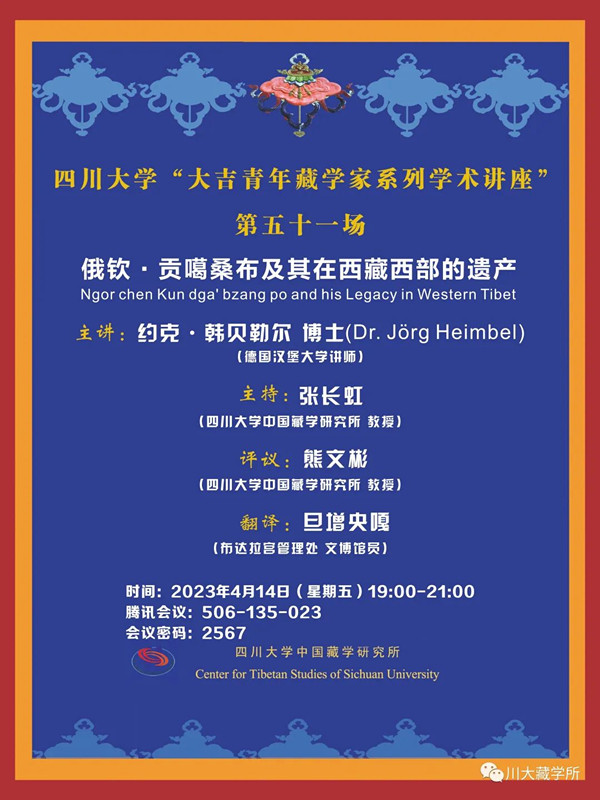

讲座内容摘要:
俄钦·贡噶桑布(Ngor chen Kun dga’ bzang po, 1382–1456)是15世纪西藏最杰出、最有影响力的一位萨迦派大学者。在他众多有影响力的活动中,最让人记忆深刻的是俄钦于1429年在遥远的俄尔河谷创建了俄尔·艾旺却丹寺(简称俄尔寺),位于桑珠孜(今日喀则市)西南约30公里。
俄尔寺很快就成为了萨迦派一个新的密教学习中心。作为领先的密宗大师,俄钦培养了整整一代新学生,培养了该教派最聪慧的学者。基于他对于密教仪轨和修行的独特理解,俄钦成为了俄尔派的创始人,这一派别很快就发展成为萨迦派最重要的一个支系。
尽管位于卫藏地区,俄尔派及其堪布的影响延伸至远。最初,其影响扩展至西藏西部阿里地区,包括穆斯塘、普兰、古格、斯比蒂和拉达克。在接下来的几个世纪里,俄尔派扩展至东部的康区,在德格、岭仓和嘎巴等地非常有影响。
此次讲座将对俄尔派影响力最早传播的西藏西部广大地区进行近距离考察。那里的寺院、庙宇和石窟遗址与俄钦及其弟子们的活动有着密切的联系。通过对这些遗址背后的故事进行发掘和编织,我们可以更好地了解俄钦的遗产及俄尔派在西藏西部地区的发展。
主讲人简介:
约克·韩贝勒尔博士(Dr. Jörg Heimbel)本科毕业于德国哥廷根大学,硕士、博士毕业于德国汉堡大学,以博士论文《俄钦·贡噶桑布(1382-1456):萨迦派支系俄尔派创始人的生平和时代调查》取得西藏文化与宗教专业博士学位。长期从事西藏宗教与文化以及社会人类学研究。曾经在西藏大学进修高级藏语,在尼泊尔国际研究院从事古代写本调查、编目和数据库项目研究,现为德国汉堡大学藏学研究讲师。出版有专著《斯比蒂俄尔派寺院——郭米寺的建立及其在西藏西部宗教史上的地位》(2019)、《金刚总持在人间——俄钦·贡噶桑布的生平与时代》(2017)以及论文《德格的俄尔派上师:任命贝丹却迥(1702-1759)的文本图解》《俄尔堪布肖像:纪念唐卡(dus thang)》《俄钦·贡噶桑布谈酒和肉的过错》《克珠杰与俄钦之争:西藏传记书写的表现与作用》等论文十余篇。
Ngor chen Kun dga' bzang po and his Legacy in Western Tibet
Jörg Heimbel
(University of Hamburg)
The tantric expert Ngor chen Kun dga’ bzang po (1382–1456) was one of the most outstanding and influential Saskya masters of fifteenth-century Tibet. Among his many influential activities, Ngor chen is best remembered for founding the monastery of Ngor Ewaṃ chos ldan in the remote Ngor valley in 1429, some 30 kilometres south-west of bSam ’grub rtse (present-day gZhis ka rtse).
Ngor immediately became a new centre for tantric training within the monastic circles of the Saskya school. As the leading tantric expert, Ngor chen trained a whole new generation of young students, producing some of the school’s brightest minds. Based on his distinctive understanding of tantric ritual and practice, Ngor chen became the founding father of the Ngor tradition, which quickly developed into the most prominent branch of the Saskya school.
Although located in central Tibet, the religious influence of Ngor and its abbots extended much further. Initially, it extended to Western Tibet (mNga’ ris), including Mustang (Glo bo), sPu rang, Gu ge, Spiti (sPyiti), and Ladakh (La dwags). In the following centuries, the influence also spread eastwards to Khams, where the tradition became very influential in sDe dge, Gling tshang, and sGa pa.
In this talk we will take a closer look at the wider area of Western Tibet, where the influence of the Ngor tradition first spread. A network of monasteries, temples, and cave sites will be presented that can be linked to the activities of Ngor chen and his disciples. By weaving together the stories behind these sites, we will gain a better understanding of the legacy of Ngor chen and his tradition in Western Tibet.